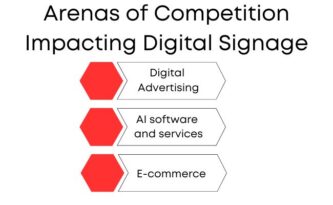
By Alan C. Brawn CTS, DSCE, DSDE, DSNE, DCME, DSSP, ISF-C
This is a “sister” piece to my article about research methodologies posted on Sixteen-Nine. That article is entitled “Listen to the Right Voices”. It unmasks most “research” as questionable, if not inaccurate and misleading. If a company listens to the wrong voices they will make the wrong choices. As Detective Joe Friday used to say on the iconic tv show Dragnet, “Just the facts ma’am, just the facts”. Separating fact from fiction is critical today more than ever before. As a teaser for my soon to be published article on the topic of research at Sixteen-Nine, I do suggest several research sources that are dependable, and those that you can use to make good business decisions…

The impetus for this article is the glaring need to delve into reliable information that can help you understand the conditions in which your company exists and assist you in “adjusting” to those conditions both immediately, and in the near and mid-terms. There is no better example than a report I just received from the McKinsey Global Institute. The report is entitled “The Next Big Arenas of Competition”. It is 185 pages in length, each page packed with valuable information. I recognize that most won’t want or be able to invest the time to read it cover to cover so I have decided to provide an unsolicited and unaffiliated cliff notes version of three arenas for those inquiring minds that want to know but do not have the time. Buckle up!
They define business “arenas” as having two characteristics: “high growth and dynamism”. These arenas capture an “outsize share of the economy’s growth, and the market shares of players within them change to an outsize degree.” The McKinsey researchers have identified 18 potential arenas of the future that according to them could “reshape the global economy, generating $29 trillion to $48 trillion in revenues by 2040.” Their estimates show that these future arenas could generate $2 trillion to $6 trillion in profit by 2040. Their collective share of global GDP could increase from 4 percent to 10 to 16 percent by 2040. Got my attention… I hope it get yours.
I won’t take the space to go over the entire list of 18 arenas but know that each one affects digital signage in some ways. For those interested here is the link to the full report:
https://www.mckinsey.com/mgi/our-research/the-next-big-arenas-of-competition.

For us in AV and digital signage, here are three arenas (along with excerpts from the full report) that most directly affect us:
- Digital advertising
- “Digital advertising is expected to continue to grow faster than GDP. In our estimates, revenues from digital advertisements increase from $520 billion in 2022 to $2.1 trillion in the lower range of scenarios and to $2.9 trillion in 2040 in the higher range of scenarios, a CAGR of 8 to 10 percent. Much of this growth comes from the ongoing shift in advertising spend from traditional to digital media: in 2022, digital advertisements accounted for 65 percent of total advertising, a share that is expected to grow to 80 to 90 percent by 2040. The growth of digital ads is primarily driven by four factors: growth of the global middle class, consumer attention moving to digital, the demonstrated ROI of digital ads, and new forms of digital media.”
- E-commerce
- “Our overall sizing of the industry has two main segments: retail e-commerce and food e-commerce (shipping costs excluded). The retail e-commerce segment includes categories of consumer goods such as general merchandise, apparel, and appliances. Together, the revenues of the two segments reached roughly $4 trillion in 2022. That could grow to between $14 trillion and $20 trillion by 2040, a CAGR of 7 to 9 percent. The retail e-commerce segment currently accounts for one-fifth of global retail revenues (both online and offline), and that share could reach 27 to 38 percent by 2040. In our estimates, revenues could grow from $3.4 trillion in 2022 to $11 trillion by 2040 in the lower range of scenarios and to $16 trillion in the higher range of scenarios.
- “Meanwhile, the food e-commerce segment brings in $630 billion in revenues today, or 4 percent of global retail revenues. That could grow to $3 trillion by 2040 in the lower range of scenarios and to $4 trillion in the higher range of scenarios, or 7 to 9 percent of global retail revenues.”
- AI software and services
- “Developments in analytical AI and gen AI are poised to drive the industry’s growth by improving business and worker productivity. In our modeled scenarios, the arena’s revenues grow from $85 billion in 2022 to $1.5 trillion in a lower range of scenarios in 2040 and to $4.6 trillion in a higher range of scenarios, a CAGR of 17 to 25 percent. Past McKinsey research analyzed more than 500 uses for AI and estimated their potential economic, which would have two components.
- The first is the economic value added by analytical AI—such as machine learning and deep learning—which could amount to an estimated $9.4 trillion to $15 trillion in 2040.
- The second component is the economic value added by gen AI. About $2.6 trillion to $4.4 trillion of that annual value would come from gen AI enterprise use cases, and about three-quarters of that value would be in four areas: customer operations, marketing and sales, software engineering, and R&D.
- These use cases include those that reduce costs as well as those that increase revenue for individual firms, overall increasing productivity in the economy. But these enterprise use cases do not account for all the productivity gains of individual knowledge workers, automating aspects of their occupations. Incorporating all these cases of individual worker productivity enabled by gen AI in addition to the enterprise use cases could unlock a total of $6.1 trillion to $7.9 trillion of value annually. Adding these components together yields our estimated range of total economic potential of $15.5 trillion to $22.9 trillion annually by 2040.
- “Developments in analytical AI and gen AI are poised to drive the industry’s growth by improving business and worker productivity. In our modeled scenarios, the arena’s revenues grow from $85 billion in 2022 to $1.5 trillion in a lower range of scenarios in 2040 and to $4.6 trillion in a higher range of scenarios, a CAGR of 17 to 25 percent. Past McKinsey research analyzed more than 500 uses for AI and estimated their potential economic, which would have two components.
When I write about listening to the right voices and making the right choices, I use McKinsey as a prime example and certainly one voice to listen to. This particular report stands out because it illustrates the depth of research that should be a predicate to earning our attention. Words are cheap. Research is not. The report benefits us by focusing on 18 arenas that experts state will impact the global economy. It tells us where we are and where we are most likely going. Think of a reliable crystal ball. My parting shot is simple. Look at a variety of vetted sources that use primary research as their foundation. Look at their methodology and depth of information. Compare notes and then act with renewed confidence about the quality of information and what you have discovered.






